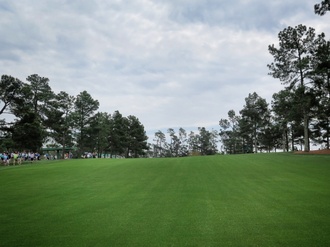The 17th Without Ike's Tree, A Year Later
/I know you all have committed to memory my Golf World story from 2014 on how Augusta National's 17th hole played without Ike's Tree. Amazingly the landing area was much easier to hit even though most players insisted the tree had no impact. The 17th on Monday, 2015 Masters (Click to enlarge)And yet with the fairway hit percentage climbed 11%, the scoring average went up in 2014 and the fewest number of GIR's were registered since 2006 (42%). That was down 7% from the previous year.
The 17th on Monday, 2015 Masters (Click to enlarge)And yet with the fairway hit percentage climbed 11%, the scoring average went up in 2014 and the fewest number of GIR's were registered since 2006 (42%). That was down 7% from the previous year.
So 11% more balls finished in the fairway and from there we saw a 7% drop in GIR's. I theorized in the Golf World story that the loss of the tree led to more 3-woods and therefore more players playing blind to one of the most difficult greens on the planet. Seeing as much of the green as you can is vital there, as Phil Mickelson explained in today's press conference.
PHIL MICKELSON: It really doesn't any play different because it wasn't really in play for most players that hit the ball high enough. It was in play for some guys that couldn't quite carry it over that tree, maybe a quarter of the field. I don't think it's going to affect scoring too much. The challenge is really the approach shot into the green in that you can't see the green because it's so flat and hidden by the bunker. It's very difficult for depth perception and difficult for distance control with you're dealing with that elevation change and it's difficult to hit the ball online because you're hitting off an uphill lie. Most people pull that shot and you're trying to hit a cut to a lot of the right‑handed pins for a right‑handed player.
It's a challenging hole because of the other subtleties and nuances of the hole, not so much the tree you were past after your first shot.
Paul Rogers talked to Geoff Ogilvy about his return to Augusta and his design influences, and Ogilvy had this to say about his first time back at 17?
Upon his return to Augusta this year, Ogilvy said, he did a “double-take” when he stood on the 17th tee and saw that the Eisenhower Tree, a broad loblolly pine, was missing, having been destroyed in a storm prior to last year’s Masters. “To my eye, it looks better,” he said of the hole, before adding that a precious “bit of history” had been lost.
Ogilvy described the green at No. 17 as his favorite on the course, for the subtlety of the rolls despite the fact that the putting surface was fashioned from a piece of relatively nondescript land.
And Tiger also is seeing 17 for the first time post-Ike's Tree.
I just find it fascinating that they keep changing this place, it seems like, every year and it looks exactly the same, like it's never been touched. It's just fascinating.
I didn't play last year so I didn't see when the Eisenhower Tree was gone. I didn't realize 17 was straight ahead. I always thought it was a little bit of a dogleg‑left. It's eye opening to see it's just dead‑straight. That was very, very shocking to me to see it like that.
Q. Do you like it now?
TIGER WOODS: I loved it the way it was. That tree, I've hit it too many times, trust me. I've had my issues on that hole, that tree. But I thought it was a fantastic hole. It's iconic, that tree, and I don't think you can ever, ever replace it.











